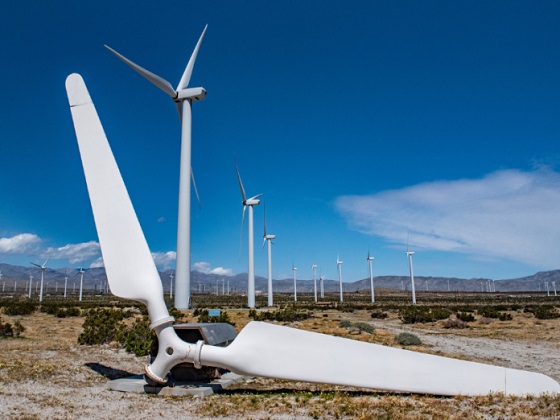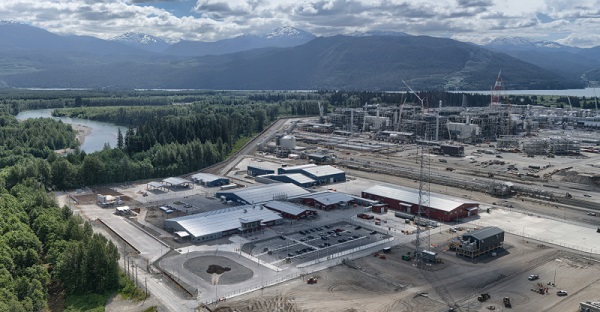Energy
Buckle Up for Summer Blackouts: Wind Is Already Failing Texas in Spring

From Heartland Daily News
By Jason Isaac
When the wind blows too much, natural gas plants are forced to shut down because they can’t underbid wind producers that can bid zero or negative. But when the wind doesn’t blow when it is needed, wind generators can afford the loss of revenue because they earn so much from tax subsidies.
It’s been all quiet on the electric grid front for a few months — but don’t get your hopes up. Over the last month, electricity prices came near the $5000/MWh regulatory cap three separate times because the wind wasn’t blowing enough when the sun went down.
If this sounds familiar, you’re not wrong.
You may hear from the drive-by media that the problem is unseasonably warm temperatures, or that there are a lot of power plants down for maintenance. But high 80s in April and low 90s in May are not unusual, and the Texas grid used to manage these weather changes with no problems. From 2014 to 2016, real-time prices only went over $1000/MWh twice, but it’s happened three times already this year.
If the grid is already on shaky ground, with many weeks to go before blistering triple-digit temperatures shoot electric demand through the roof, all signs are pointing to an unpleasant summer.
The problem with the Texas grid is so simple it’s infuriating: Relying too heavily on unpredictable wind and solar, without enough reliable reserve capacity, means higher volatility — leading to higher prices and increasing need for expensive interventions by ERCOT to avoid outages. This is why your electric bill is going up and up even though wind and solar are supposed to be cheap.
While Texas certainly has a lot of sun, peak solar output almost never aligns with peak electric usage. The Lone Star State also has plenty of wind, but wind generation is wildly unpredictable — by nature. It’s not unusual for a wind generator’s output to swing 60 percentage points or more in a single week.
Take last month, for example. On Tuesday, April 16, electricity prices reached their cap because ERCOT’s day-ahead wind forecast was off by 50%. Five gigawatts of wind we were counting on to power Texas as the sun went down didn’t show up. That was the equivalent of simultaneously shutting down 10 large natural gas units, or all of the state’s nuclear capacity. If the latter occurred, the news media would be up in arms (and rightfully so). But because the culprit was the political darling of both the left and the right, no one heard about it.

ERCOT hasn’t been the best at predicting wind output, and the problem isn’t entirely its fault. Wind veers so wildly between extremes it’s nearly impossible to plan a sustainable grid around its fickleness — yet wind makes up 26% of our generating capacity.
It’s all because lucrative tax breaks and subsidies at the state and federal level, combined with flaws in ERCOT’s market design, make it almost impossible for wind to lose money — and harder than ever for natural gas to compete, even though it’s far more reliable and affordable. When the wind blows too much, natural gas plants are forced to shut down because they can’t underbid wind producers that can bid zero or negative. But when the wind doesn’t blow when it is needed, wind generators can afford the loss of revenue because they earn so much from tax subsidies.
Imagine trying to open a restaurant when your competitor next door is paying its customers to eat there. It’s no wonder natural gas capacity in ERCOT has barely grown over the past decade, and not enough to make up for losses of coal plants, while demand has been steadily increasing.
All those subsidies are hurting our most reliable, affordable energy producers and putting our economy at risk — leaving you and me, the taxpayers on the hook.
While most political issues are far more complex and nuanced than brazen attack ads and headlines would lead you to believe, in this case, it really does boil down to one simple problem.
And it would be easy to solve — if lawmakers are willing to go against the grain of political correctness and set a clear reliability standard for the wind and solar generators that want to connect to our grid.
Unfortunately, that’s a gargantuan “if.”
As a former lawmaker, I understand the pressures our legislators are under to toe the line on alternative energy. Major utilities embracing World Economic Forum- and United Nations-aligned “energy transition” policies that seek to redefine what’s “clean” and what’s “pollution” are making matters worse. And the incessant misinformation from their well-funded lobby that promise rural “economic development” and “cheap energy” sound too good to be true, because they are.
Elected officials don’t serve the lobby. They serve Texans — or, at least, they should.
And Texans want a reliable, affordable grid. They want to not have to worry about losing power in the heat of the summer or the dead of winter. The Legislature must put a stop to these market-distorting subsidies and make reliability, not popularity, the priority for our electric grid.
Gov. Greg Abbott sent a letter on July 6, 2021 to members of the Public Utility Commission of Texas (PUC) directing them to “take immediate action to improve electric reliability across the state.” The second directive was to “Allocate reliability costs to generation resources that cannot guarantee their own availability, such as wind or solar power.” Unfortunately, the PUC hasn’t acted on this directive or even studied it. The costs of scarcity on the grid are estimated to have exceeded $12B in 2023, which is equal to two-thirds of the property tax relief passed in the 88th Legislature, all paid for by ratepayers.
“Unfortunately for Texans, the ERCOT grid is moving from a single grid with gas and coal power plants running efficiently all day to two grids: one for wind and solar and one for expensive backup power that fills in the gaps when there is not enough wind and sun,” says Dr. Brent Bennett, policy director for Life:Powered at the Texas Public Policy Foundation. “Every time these scarcity events occur, whether due to real scarcity or artificial scarcity created by ERCOT’s operating policies, ratepayers are shelling out tens to hundreds of millions of dollars for backup power. It is the most expensive way to operate a grid, and Texans will feel the bite as these costs are absorbed over time.”
The Californication of our grid is unfolding before our eyes. If the Legislature and the PUC don’t act fast, the Texas miracle won’t last.
The Honorable Jason Isaac is CEO of the American Energy Institute and a senior fellow at the Texas Public Policy Foundation. He previously served four terms in the Texas House of Representatives
Energy
CNN’s Shock Climate Polling Data Reinforces Trump’s Energy Agenda


From the Daily Caller News Foundation
As the Trump administration and Republican-controlled Congress move aggressively to roll back the climate alarm-driven energy policies of the Biden presidency, proponents of climate change theory have ramped up their scare tactics in hopes of shifting public opinion in their favor.
But CNN’s energetic polling analyst, the irrepressible Harry Enten, says those tactics aren’t working. Indeed, Enten points out the climate alarm messaging which has permeated every nook and cranny of American society for at least 25 years now has failed to move the public opinion needle even a smidgen since 2000.
Appearing on the cable channel’s “CNN News Central” program with host John Berman Thursday, Enten cited polling data showing that just 40% of U.S. citizens are “afraid” of climate change. That is the same percentage who gave a similar answer in 2000.
Dear Readers:
As a nonprofit, we are dependent on the generosity of our readers.
Please consider making a small donation of any amount here.
Thank you!
Enten’s own report is an example of this fealty. Saying the findings “kind of boggles the mind,” Enten emphasized the fact that, despite all the media hysteria that takes place in the wake of any weather disaster or wildfire, an even lower percentage of Americans are concerned such events might impact them personally.
“In 2006, it was 38%,” Enten says of the percentage who are even “sometimes worried” about being hit by a natural disaster, and adds, “Look at where we are now in 2025. It’s 32%, 38% to 32%. The number’s actually gone down.”
In terms of all adults who worry that a major disaster might hit their own hometown, Enten notes that just 17% admit to such a concern. Even among Democrats, whose party has been the major proponent of climate alarm theory in the U.S., the percentage is a paltry 27%.
While Enten and Berman both appear to be shocked by these findings, they really aren’t surprising. Enten himself notes that climate concerns have never been a driving issue in electoral politics in his conclusion, when Berman points out, “People might think it’s an issue, but clearly not a driving issue when people go to the polls.”
“That’s exactly right,” Enten says, adding, “They may worry about in the abstract, but when it comes to their own lives, they don’t worry.”
This reality of public opinion is a major reason why President Donald Trump and his key cabinet officials have felt free to mount their aggressive push to end any remaining notion that a government-subsidized ‘energy transition’ from oil, gas, and coal to renewables and electric vehicles is happening in the U.S. It is also a big reason why congressional Republicans included language in the One Big Beautiful Bill Act to phase out subsidies for those alternative energy technologies.
It is key to understand that the administration’s reprioritization of energy and climate policies goes well beyond just rolling back the Biden policies. EPA Administrator Lee Zeldin is working on plans to revoke the 2010 endangerment finding related to greenhouse gases which served as the foundation for most of the Obama climate agenda as well.
If that plan can survive the inevitable court challenges, then Trump’s ambitions will only accelerate. Last year’s elimination of the Chevron Deference by the Supreme Court increases the chances of that happening. Ultimately, by the end of 2028, it will be almost as if the Obama and Biden presidencies never happened.
The reality here is that, with such a low percentage of voters expressing concerns about any of this, Trump and congressional Republicans will pay little or no political price for moving in this direction. Thus, unless the polls change radically, the policy direction will remain the same.
David Blackmon is an energy writer and consultant based in Texas. He spent 40 years in the oil and gas business, where he specialized in public policy and communications.
Energy
LNG Export Marks Beginning Of Canadian Energy Independence

From the Frontier Centre for Public Policy
Kitimat’s LNG launch ends years of delay, weak policy and lost opportunity. This is a strategic turning point for Canada
Last week marked a turning point for Canadian sovereignty. On July 1, 2025, the tanker Gaslog Glasgow departed Kitimat, B.C., carrying Canada’s first-ever commercial liquefied natural gas (LNG) export to Asia. More than a shipment, it signalled the end of our economic vassalage to the United States and a long-overdue leap into global energy markets.
LNG Canada CEO Chris Cooper called it a “truly historic moment.” He’s right. The cargo left just days after the Kitimat plant produced its first liquefied natural gas and entered operation. The $40-billion megaproject, the largest private-sector investment in Canadian history, is now a fully functional Pacific Coast export hub. It can ship up to 14 million tonnes annually, and expansion is already being discussed.
Yet this success didn’t come easily. Despite being one of the world’s largest natural gas producers, Canada lacked an LNG export terminal, largely due to political delays, regulatory hurdles and lack of federal support. That this happened at all is remarkable, given nearly a decade of federal sabotage. Prime Minister Justin Trudeau’s ideological hostility to natural gas meant rebuffed allies, stalled projects and choked-off investment.
Foreign leaders (from Japan and Germany to Greece) practically begged Ottawa to green-light Canadian LNG. Trudeau dismissed them, claiming there was “no business case.” No one in his caucus dared contradict him. The result: lost time, lost markets and a near-complete surrender of our energy advantage.
But the business case was always there. Kitimat proves it.
The U.S. has been exporting LNG since 2016, giving them a nearly decade-long head start. But Canada has something our neighbours don’t: the Montney Formation. Spanning northeast B.C. and parts of Alberta, it covers about 130,000 square kilometres and holds enormous gas reserves. Montney gas, abundant and close to tidewater, trades at roughly half the Henry Hub price, giving Canada a significant cost edge.
Location seals the deal. Kitimat, perched on the Pacific, bypasses the congested Panama Canal, a major chokepoint for U.S. Gulf Coast exports, and offers a shorter, more direct route to energy-hungry Asian markets. This geographic advantage makes Canadian LNG not only viable but globally competitive.
In 2024, Canada exported about 8.6 billion cubic feet of gas daily to the U.S. via pipeline. With Kitimat, we finally begin breaking that one-market dependency. We also start clawing back the price differential losses that come with being captive sellers. This is how you build productivity, strengthen the dollar and reclaim economic independence from Washington.
The economic ripple effect is massive. The Kitimat build created 50,000 jobs at its peak, generated $5.8 billion in Indigenous and local contracts and left behind more than 300 permanent positions. Provincial revenues are projected in the tens of billions. In an era of anaemic growth, this is real stimulus and has staying power.
Predictably, critics raise environmental concerns. But this critique ignores global realities. Exporting Canadian natural gas to countries still burning coal is not a step backward—it’s a practical advance. Natural gas is up to 25 per cent cleaner than coal when comparing full lifecycle emissions (that is, from extraction to combustion). Global emissions don’t respect borders. If Canada can displace dirtier fuels abroad, we’re part of the solution, not the problem.
And this is only the beginning. Cedar LNG and Woodfibre LNG are already under construction. Atlantic Coast projects are in the queue. We must now defend this momentum against bureaucratic delays, activist litigation and ideological roadblocks.
LNG is not a climate villain. It’s a bridge fuel that cuts emissions, creates wealth and helps fund our national future.
Marco Navarro-Genie is vice-president of research at the Frontier Centre for Public Policy and co-author, with Barry Cooper, of Canada’s COVID: The Story of a Pandemic Moral Panic (2023).
-

 Fraser Institute1 day ago
Fraser Institute1 day agoBefore Trudeau average annual immigration was 617,800. Under Trudeau number skyrocketted to 1.4 million annually
-

 MAiD1 day ago
MAiD1 day agoCanada’s euthanasia regime is already killing the disabled. It’s about to get worse
-

 Frontier Centre for Public Policy1 day ago
Frontier Centre for Public Policy1 day agoNew Book Warns The Decline In Marriage Comes At A High Cost
-

 Business1 day ago
Business1 day agoPrime minister can make good on campaign promise by reforming Canada Health Act
-

 Addictions1 day ago
Addictions1 day ago‘Over and over until they die’: Drug crisis pushes first responders to the brink
-

 International1 day ago
International1 day agoChicago suburb purchases childhood home of Pope Leo XIV
-

 Daily Caller1 day ago
Daily Caller1 day agoUSAID Quietly Sent Thousands Of Viruses To Chinese Military-Linked Biolab
-

 Business2 days ago
Business2 days ago103 Conflicts and Counting Unprecedented Ethics Web of Prime Minister Mark Carney


